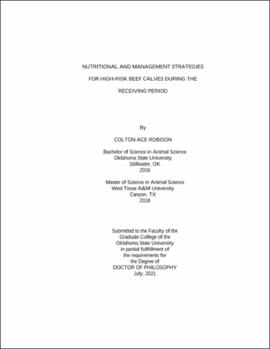| dc.contributor.advisor | Wilson, Blake K. | |
| dc.contributor.author | Robison, Colton Ace | |
| dc.date.accessioned | 2022-01-09T19:44:15Z | |
| dc.date.available | 2022-01-09T19:44:15Z | |
| dc.date.issued | 2021-07 | |
| dc.identifier.uri | https://hdl.handle.net/11244/333658 | |
| dc.description.abstract | Crossbred beef steers (n = 605; initial BW = 255 +/- 8.3 kg) were randomly assigned to 1 of 2 treatments upon arrival to the feedlot. Steers were either administered metaphylactic antimicrobial treatment at arrival (MET) or received no antimicrobial treatment (CON). No differences in BW existed between CON and MET steers throughout the experiment (P >/= 0.44). Average daily gain was greater (P < 0.01) for MET steers than for CON steers from d 0 to 14. Performance and hematological differences were evaluated within CON steers that were either treated (TRT) or not treated (NTRT) for BRD. Body weight was consistently greater (P < 0.02) for NTRT steers compared to TRT steers; however, no differences (P >/= 0.12) in ADG were detected. Neutrophil counts tended (P = 0.08) to be greater for NTRT steers than for TRT steers, but no further differences (P >/= 0.16) in leukocyte concentrations existed. Treated CON steers had lower (P </= 0.05) hematocrits, hemoglobin, and mean corpuscular hemoglobin than NTRT steers. In Exp. 2, newly received heifers (n = 557; initial BW = 230 +/= 33 kg) were randomly allocated to diets containing 15% roughage (R15), 30% roughage (R30), or 45% roughage (R45). Heifer BW decreased linearly (P </= 0.01) with decreasing roughage inclusion after d 28 of the experiment. There was a linear decrease (P </= 0.01) in ADG as roughage concentration increased. Dry matter intake increased linearly (P </= 0.01) and G:F linearly decreased (P </= 0.04) as dietary roughage concentration increased. No responses (L, P >/= 0.44; Q, P >/= 0.11) were detected for overall BRD treatment or other clinical measures. Roughage concentration had no impact (P >/= 0.11) on serum metabolites. In Exp. 3, newly received heifers were randomly assigned to receive a nutrient-rich bolus at processing (BOL) or received an empty gelatin bolus (CON). No differences (P >/= 0.11) in BW, ADG, DMI, G:F, or health outcome were detected between treatments. Glucose concentrations were greater (P < 0.01) for CON cattle on d 14; however, no further differences (P >/= 0.20) in metabolite concentrations were observed. | |
| dc.format | application/pdf | |
| dc.language | en_US | |
| dc.rights | Copyright is held by the author who has granted the Oklahoma State University Library the non-exclusive right to share this material in its institutional repository. Contact Digital Library Services at lib-dls@okstate.edu or 405-744-9161 for the permission policy on the use, reproduction or distribution of this material. | |
| dc.title | Nutritional and management strategies for high-risk beef calves during the receiving period | |
| dc.contributor.committeeMember | Taylor, Jared D. | |
| dc.contributor.committeeMember | Beck, Paul A. | |
| dc.contributor.committeeMember | Reuter, Ryan R. | |
| osu.filename | Robison_okstate_0664D_17245.pdf | |
| osu.accesstype | Open Access | |
| dc.type.genre | Dissertation | |
| dc.type.material | Text | |
| dc.subject.keywords | bovine respiratory disease | |
| dc.subject.keywords | dietary roughage | |
| dc.subject.keywords | energy density | |
| dc.subject.keywords | feedlot | |
| dc.subject.keywords | metaphylaxis | |
| dc.subject.keywords | receiving cattle | |
| thesis.degree.discipline | Animal Science | |
| thesis.degree.grantor | Oklahoma State University | |
